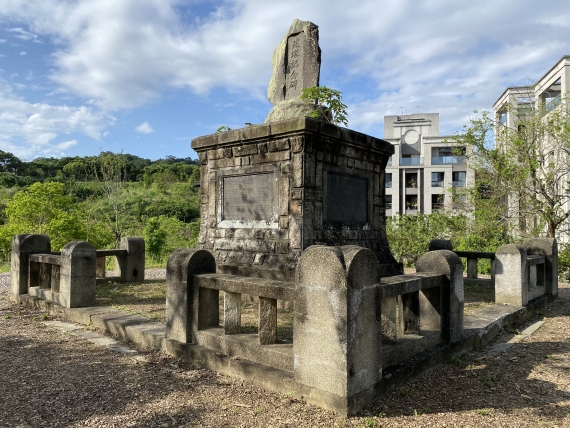Xingfu Village Monument

Xingfu Village Monument is located on a hill in the south of Wenshan Forest Park. Go eastward on Xingshun Street and move along toward the ridge of a mountain road across No. 197 of the street for 50 m, and you will find the monument.
This monument, registered as a city-designated historic site of Taipei City in 2008, commemorates a charitable event in 1929 (the 4th year of the Showa era) when public donations were made to build graves for deceased individuals from poor families. At the time, many poor people could not afford a grave to bury themselves after they died. To ease their financial burden, the Japanese colonial government launched a campaign to solicit donations from public in general, used the donations to purchase about 50 kas of land in Dazhi Village in the north of Taipei City and 30 kas of land in Xingfu Village in the south of the city (one ka equals 0.0097 m2), and repurpose the land into public graveyards. The monument was erected in remembrance of this act of philanthropy in 1930 (the 5th year of the Showa era)
On its official website, the Department of Cultural Affairs of Taipei City Government presents an introduction of Xingfu Village Monument:
“‘Xingfu Village Monument is a Japanese-style monument that stands on a mountain ridge, and it sticks out when viewed from afar. The square monument still retains its structural integrity, with a natural stone sitting on the top and a curved surface at the bottom projecting outward. All sides of the foundation of the monument consists of Kuan-Yin stone tablets with a deeply incised inscription that captures the zeitgeist of the time and is imbued with artistic value. The clearly legible inscription chronicles, in painstaking detail, how donations were collected from all quarters of society, how the land in Xingfu and Dazhi was bought for graveyard construction, and who the donors and businesses were. Many of the donors were members of the elite class, such as Gu Xianrong, Chen Tianlai, Lin Boshou, and Xu Bing. An examination of the inscription and the donors’ names reveals the monument’s historical meaning, offering a glimpse into how the graveyards were built using public donations and how kind-hearted those donors were. The monument, preserved in its original location, has witnessed the evolution of Taipei City and the funded construction of graveyards during the Japanese colonial period.”

最新自 何文賢 / He Wen-hsien
- 1960年代的景美菜市場
- 己亥年(108年)景美聯合遶境
- 壬辰年(民國101年)景美集應廟迎香慶典
- 壬辰年(民國101年)景美聯合遶境慶典
- 文山興安宮
- 古亭地政事務所
- 未有大樓前的景美街景
- 由景文街看車前路
- 車前路地貌的改變
- 辛卯年(民國100年)北投集應廟至景美迎回保儀
- 原車前路上順泰玩具食品行
- 高選風遺墨
- 景文街林鶴年醫院舊宅
- 景美集應廟豬公祭典(一)
- 景美舊橋封橋待拆除
- 開道碑重置揭幕
- 瑠公圳舊道與新道會合點
- 興隆市場
- 1970年以前景美的工廠及公營機構
- 1980年以後景美的工廠及公營機構
- Liugong Bridge: the First Reinforced-Concrete Bridge in Taiwan
- Expected Changes for the Landscape of Jingmei After 2020
- Landscape of Jingmei during 2000–2020
- Landscape of Jingmei during 1980–2000
- Landscape of Jingmei during 1960–1980
- Landscape of Jingmei before 1960
- The Stealthy Wansheng River
- Turning Jingmei River Channels into Parks
- A Potential Archeological Site of Shiwufen
- Earth God Temple in Jingmei
- History of Wan-Xin Railway
- Liugongjun and Wooden Trough Bridge
- History of Jingmei Bridge
- Coal Mining in Wenshan District
- Important Infrastructures in Wenshan District from the Past
- Changes in Jingmei’s Geography and Road Infrastructure
- History of Jingmei
- 霧裡薛圳圳路
- 景美街1號與2號距離遠
- 景美行政變遷
- 景美老街拱形騎樓元素
- 都更下的景美街困境
- 2000年至2020年景美地景變遷
- 1960年以前景美地景樣貌
- 1960年至1980年景美地景變遷
- 1980年至2000年景美地景變遷
- 2020年後景美地景變遷的期待
- 景美街商業土地使用分區
- 原貌仍在的泰興染織廠
- 中農化工廠基地變遷
- 1980年以後景美的工廠及公營機構
- 1970年以前景美的工廠及公營機構
- 興福庄「建塚記念碑」
- 金獎外觀興隆市場
- 臺北花木批發市場
- 疑似十五份遺址
- 會元洞清水祖師廟
- 景美福興宮
- 景美瑠公圳暨成巷道
- 景美忠勤三莊新面向
- 景美「賴氏萬壽塔」
- 頂公館福德宮
- 消失的興福庄浚溝修路石碑
- 和伯公紀念會館
- 台北江西會館及萬壽宮
- 在興隆路的台北畜產運銷公司
- 在景美的古亭地政事務所
- 文山興安宮
- 文山溪洲福德宮
- 三福街古道
- 十五分火車站
- 十五分庄舊地名
- 木柵集應廟保儀尊王巡境貓空
- 甲午年(103)木柵集應廟巡境慶典
- 景美集應廟豬公祭典
- 仙跡岩拾遺
- 仙跡岩的民間信仰
- 仙跡岩舊八景
- 龍吃水的地理景觀
- 圳後山的圖根點
- 景美山的三角點
- 百年金龜樹生病了
- 景美其他的老樹
- 景行公園的老樹
- 景美養工處老樹
- 巷內的魯花樹
- 興安宮的老榕樹
- 景豐街的老樹
- 萬有公園的老樹
- 萬和公園的老樹
- 景美國中的老樹
- 景美國小附近老樹
- 景美國小的老樹
- 萬新鐵路的歷史
- 景美聖方濟沙勿略堂
- 景美的西方教會彙總
- 味自慢居酒屋
- 義興樓食堂
- 景美的春燕
- 萬盛溪舊溪床旁的春燕


